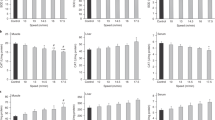Abstract
The aim of the present study was to examine the effect of different kinds of physical exercise on plasma glutathione levels. Male Wistar rats were randomly divided into four groups: In walking group (W; n=6), rats were trained to walk 0.8 m/min for 45 min; slow running group (SR; n=6) were trained to run 4 m/min for 45 min; fast running group (FR; n=6) ran 8m/min for 60 min and control rats (C; n=6) remained in their home cages. All animals were sacrificed after exercise and the levels of reduced glutathione (GSH) in plasma samples determined by high performance liquid chromatography (HPLC) with a fluorescent detector. Compared to controls, exercise did not change GSH plasma levels of the W group. A tendency to decrease blood GSH was observed in plasma samples of the SR group and in the FR group, physical exercise resulted in a dramatic decrease in GSH plasma levels. These data suggest that during light physical exercise there is a low production of reactive oxygen species (ROS) with a low request for antioxidant defence such as oxidation of GSH. The dramatic decrease observed in GSH levels in FR rats would indicate the presence of oxidative stress able to modify blood antioxidant profiles. Our results suggest that GSH plays a central antioxidant role in blood during intensive physical exercise and that its modifications are closely related to exercise intensity.
Resumen
Se examinan en este estudio los efectos de distintos tipos de ejercicio ffsico sobre los niveles plasmáticos de glutation. Para ello, rat as Wistar macho se dividen de modo aleatorio en cuatro grupos: ratas entrenadas a caminar a 0,8m/min durante 45 min (grupo W;n=6); entrenadas a correr a 4m/min durante 45 min (grupo SR; n=6); entrenadas a correr a 8m/min durante 60 min (grupo FR; n=6) y ratas control que permanecen en sus jaulas (grupo C; n=6). Todos los animales se sacrifican al final del entrenamiento para medir los niveles plasmáticos de glutation reducido (GSH) por medio de HPLC con detector fluorométrico. Respecto a los controles, el ejercicio no induce variaciones de los niveles plasmáticos de GSH en el grupo W, mientras que se observa una tendencia a la reducción de GSH en el grupo SR. En las ratas FR, en cambio, se manifiesta una marcada y significativa reducción en los valores de GSH respecto a los demás grupos. Estos datos sugieren que durante el ejercicio físico ligero existe una ligera producción de especies reactivas del oxígeno (ROS) con una baja exigencia de defensas antioxidantes, como la oxidación del glutation. La marcada disminución de GSH en el grupo FR sugiere, en cambio, la existencia de estrés oxidativo capaz de modificar la concentración de los compuestos antioxidantes de la sangre. En conclusión, nuestro estudio indica que el GSH se utiliza activamente durante el ejercicio intenso y que el estrés oxidativo asociado al ejercicio está relacionado con su intensidad.
Similar content being viewed by others
References
Gohil, K., Viguie, C., Stanley, W. C., Brooks, G. A. and Parker, L. (1988):J. Appl. Physiol.,64, 115–119.
Ji, L. L. (1999):Proc. Soc. Exp. Bio. Med.,222, 283–292.
Ji, L. L., Leeuwenburgh, C., Leichtweius, S., Gore, M., Fiebig, R., Hollander, J. and Bejima, J. (1998):Ann. N. Y. Acad. Sci.,854, 102–107.
Kleinman, W. A. and Rich, J. P. (1995):J. Chromatogr. B.,672, 73–80.
Lands, L. C., Grey, V. L. and Smountas, A. A. (1999):J. Appl. Physiol.,87, 1381–1385.
Leaf, D. A., Kleinman, M. T., Hamilton, M. and Deitrick, R. W. (1999):Am. J. Med. Sci.,317: 295–300.
Maxwell, S. R. J. (1995):Drugs,49, 345–361.
Rossi, R., Gambelunghe, C., Flaviani, M. and Rufini, S. (1996):Med. Sport,49, 311–315.
Schroder, H., Navarro, E., Tramullas, A., Mora, J. and Galiano, D. (2000):Int. J Sports Med.,21, 146–150.
Sen, C. K. (1999):Mol. Cell Biochem.,196, 31–42.
Sen, C. K. (1995):J. Appl. Physiol.,79, 675–686.
Sen, C. K., Atalay, M. and Hanninen, O. (1994):J. Appl. Physiol.,77, 2177–2187.
Sen, C. K., Rankinen, T., Vaisanen, S. and Rauramaa, R. (1994):J. Appl. Physiol.,76, 2570–2577.
Sies, H. (1991):Am. J. Med.,91 (suppl 3C) 31S-38S.
Author information
Authors and Affiliations
Corresponding author
Rights and permissions
About this article
Cite this article
Gambelunghe, C., Rossi, R., Micheletti, A. et al. Physical exercise intensity can be related to plasma glutathione levels. J. Physiol. Biochem. 57, 9–14 (2001). https://doi.org/10.1007/BF03179808
Received:
Issue Date:
DOI: https://doi.org/10.1007/BF03179808




